
Brainstorm Security Shop

For Orders Over $199

On Any Of Our Products

Details On Refund Page
You’ve likely seen throwing stars in movies, those sleek, silent weapons that seem to offer a swift solution to dangerous confrontations. As intriguing as they are, it’s crucial to understand not just how to handle them, but also where they fit legally and ethically in self-defense scenarios. While they’re compact and easily concealed, are they the right choice for you? Before you consider incorporating a shuriken into your defense strategy, let’s explore the realities—both the potential benefits and the significant risks. What you discover may surprise you and could shift your perspective on personal safety.
Throwing stars, or shuriken, originated in feudal Japan as covert weapons for ninjas. You might be fascinated to learn about their ancient origins, which are steeped in both necessity and ingenuity. These tools weren’t just weapons; they held a deep cultural significance, symbolizing the silent power and cunning of their wielders.
Originally, shuriken were used by samurai and ninjas for various purposes—distracting enemies, delivering poison, and even lighting fires from a distance. Their design allowed them to be concealed and swiftly deployed, making them perfect for espionage and surprise attacks.
Over time, they became more than just tactical tools; they evolved into symbols of the secretive lives of their users. Understanding the historical backdrop of throwing stars can give you a profound appreciation for their role in Japanese culture.
They weren’t merely tools of war but were integral to the survival strategies of ancient warriors. This deep-rooted history highlights how pivotal they were in shaping the strategies and tales of feudal Japan.
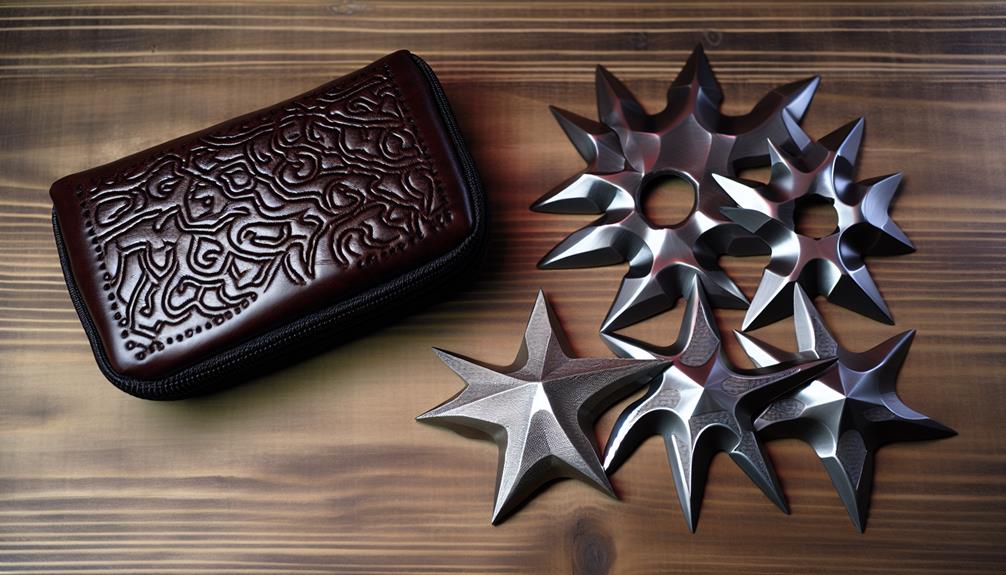
Many countries have strict regulations on the possession and use of throwing stars, recognizing them as weapons despite their historical significance.
You’ll find that across the globe, the cultural significance of these tools doesn’t necessarily protect you from legal consequences. While they’re revered in some regions for their historical and martial arts value, international regulations often classify them alongside more conventional weapons, which can lead to hefty fines or even imprisonment if you’re caught carrying them without proper authorization.
In the United States, for example, the laws vary significantly from one state to another. Some states allow you to own throwing stars, but carrying them in public could be a criminal offense.
Meanwhile, countries like Canada and the United Kingdom have outright bans on their possession. It’s crucial you understand the specific laws in your area before considering throwing stars for self-defense.
As you navigate these legal waters, remember that ignorance of the law isn’t a valid defense.
Make sure you’re fully informed about the legal status of throwing stars in your country and any country you plan to visit. This knowledge is key to avoiding unintended legal trouble while respecting the rich cultural heritage of these traditional weapons.
When selecting the right shuriken for self-defense, consider both its design and material. The choice you make should reflect a deep understanding of its practical applications, as well as its historical and cultural context. Here’s what you need to focus on:
Selecting the appropriate shuriken isn’t just about picking the coolest looking one; it’s about finding the right tool for your self-defense needs.
You’ll want to opt for shuriken that align with your specific training equipment and methods. This isn’t just about owning a piece of history; it’s about making a practical choice that integrates seamlessly into your personal defense strategy.
Always remember, the best shuriken is the one that you can handle proficiently and safely within your skill level.
Before you start practicing with shuriken, it’s crucial to grasp the basics of their handling to ensure safety and effectiveness. Understanding the different shuriken types and their unique features is the first step.
You’ve got your basic four-pointed stars, often ideal for beginners, and more complex designs like eight-pointed stars which require a bit more skill and precision.
When it comes to throwing techniques, always start with the right stance. Stand with your feet shoulder-width apart, facing your target at a slight angle. This position gives you balance and promotes accuracy when you throw.
Hold the shuriken between your thumb and forefinger, securing it at one of the points – never by the blade.
A smooth, controlled flick of the wrist is crucial for a successful throw. Don’t jerk your hand; it’s about fluid motion and follow-through.
Visualize the path you want the shuriken to take. As you release it, make sure your arm moves in a straight line toward the target, which helps in maintaining the correct trajectory.
Now that you’re familiar with the basics, it’s time to enhance your skills in throwing stars for self-defense.
You’ll learn to refine your grip and stance, which are crucial for improving accuracy and speed.
We’ll also introduce precision aiming strategies and speed enhancement drills to make you more effective and swift in real-life scenarios.
As you advance in your throwing star techniques, mastering the grip and stance is crucial. The way you hold and position yourself can make a significant difference in both accuracy and power.
Let’s dive into some essential grip techniques and stance variations to enhance your skills.
Firstly, the grip on your throwing star must be firm yet flexible. Here are a few grip techniques to try:
Now, pair these grips with the following stance variations to optimize your throwing technique:
Experiment with these techniques to find what works best for you, keeping in mind that practice is key to perfecting your throws.
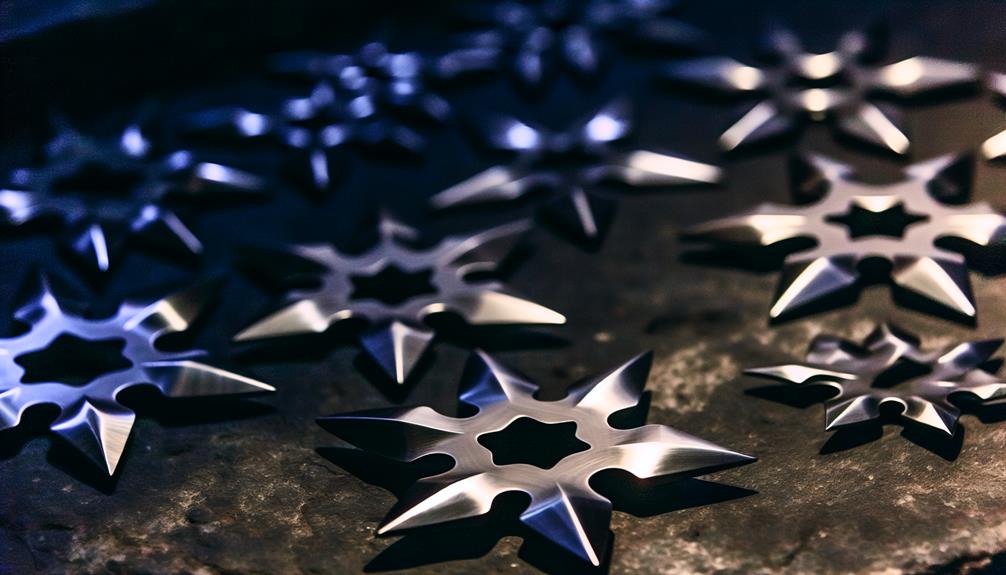
Once you’ve mastered the basics of grip and stance, honing your precision aiming becomes the next crucial step in advanced throwing techniques.
To elevate your accuracy, you’ll need to engage in focused practice, particularly through focus drills and careful target selection.
Start with choosing the right target. Opt for varied sizes and distances to challenge your skills progressively.
Begin with larger, closer targets and gradually work toward smaller, more distant ones. This gradual increase refines your aiming ability under different conditions.
Focus drills are your best tool for sharpening precision. Dedicate time to practice throwing at a single point until you can consistently hit close to or on the mark.
Then, shift the target slightly to avoid muscle memory taking over, ensuring that each throw requires active, precise aiming.
Having honed your precision with careful aiming exercises, it’s time to boost your throwing speed. Speed drills and agility training are essential to develop quick, fluid motions necessary for effective self-defense with throwing stars.
You’ll find these exercises not only enhance your speed but also improve your overall agility, making you a more formidable defender.
Here’s how you can escalate your capabilities:
Incorporate these drills into your routine three to four times a week.
You’ll notice your throwing speed increase, making you more adept at using throwing stars for self-defense.
Stay persistent, and you’ll see significant improvements in your reaction time and agility.
Mastering the use of throwing stars requires focused practice to enhance both accuracy and speed. To start, you’ll need to engage in regular target practice. Set up targets at varying distances and work on hitting them consistently. This kind of practice will not only improve your accuracy but also your confidence when handling these weapons.
Next, accuracy drills are essential. They involve more than just hitting a stationary target. Try moving targets or varying the size of the targets to challenge yourself further. It’s about replicating potential real-life scenarios where your target isn’t just standing still.
Speed is equally crucial. The faster you are, the less time your opponent has to react. Combine speed drills with accuracy training to maximize your efficiency. Remember, it’s not just about throwing quickly, but also correctly.
Here’s a table that outlines the emotional journey you might experience during your training:
| Stage | Feeling | Reason |
|---|---|---|
| Early | Frustration | Difficulty in mastering techniques |
| Mid | Determination | Improvement and overcoming challenges |
| Late | Confidence | Mastery of skills and increased effectiveness |
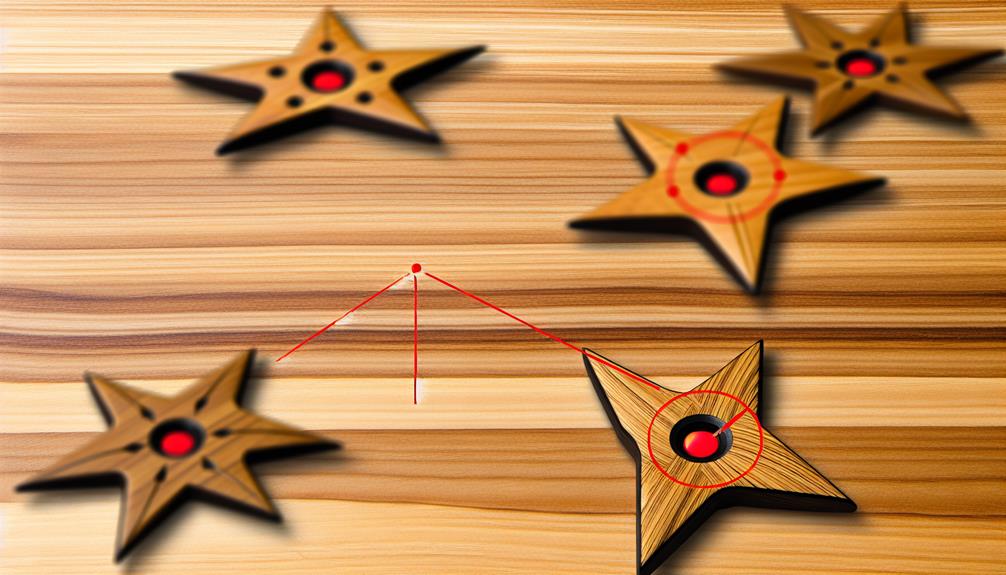
Keep pushing through the stages. With dedication, you’ll see significant improvements in both speed and accuracy.
Before you incorporate throwing stars into your self-defense routine, it’s crucial to understand the legal implications of carrying and using them.
You’ll also need to master proper handling techniques to ensure you can use them safely and effectively.
Additionally, having an emergency response plan in place is essential, in case a situation escalates beyond your control.
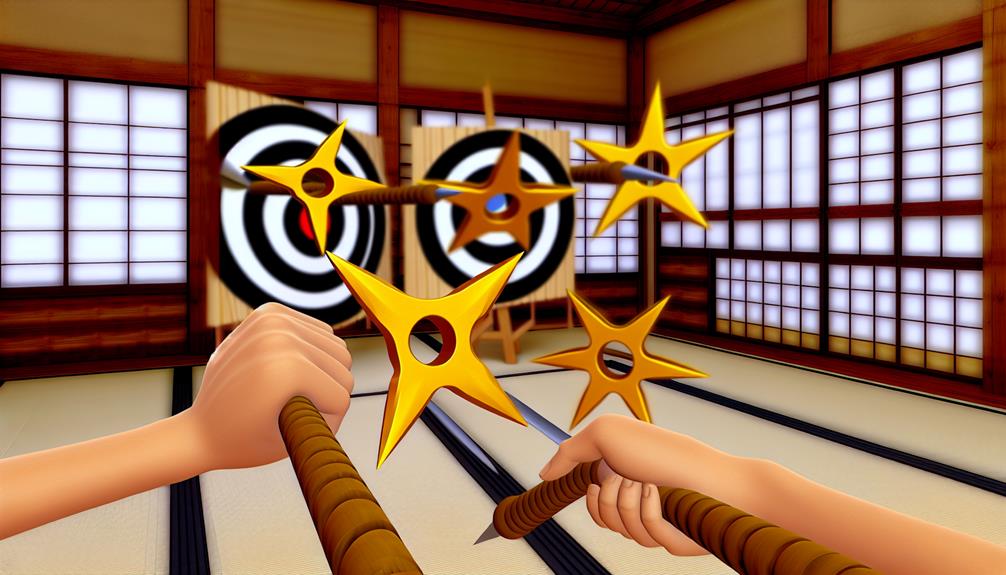
When considering the use of throwing stars for self-defense, it’s crucial to understand the legal implications. These weapons, deeply rooted in historical context and martial arts integration, vary significantly in legality depending on where you live.
It’s not just about knowing how to use these stars; it’s about understanding the broader implications of their use.
You’ll need to navigate the complex interplay of legal, ethical, and cultural factors. Remember, ignorance of the law excuses no one, and the ramifications of mishandling such weapons can be severe.
Always prioritize safety and legality over convenience in self-defense scenarios.
As you consider throwing stars for self-defense, ensuring your ability to handle them safely is just as important as understanding legal boundaries. Proper handling begins with regular shuriken maintenance.
You’ll need to keep each star clean and sharp, as a poorly maintained weapon can be unpredictable and dangerous.
You should also explore different grip variations to find what works best for you. A common method is the pinch grip, where you hold the star between your thumb and forefinger. This provides a balance between control and ease of release.
Experiment with this grip in a safe environment before using it actively in self-defense scenarios.
It’s crucial to practice in a controlled area where you can safely learn the dynamics of throwing without the risk of injuring yourself or others.
Always ensure that your practice space is secure and that there are no unintended targets in your vicinity.
If you’re incorporating throwing stars into your self-defense repertoire, it’s essential to develop a robust emergency response plan. Engaging in this type of weaponry comes with inherent risks, and preparing for any potential accidents or mishaps is crucial.
A well-thought-out emergency response plan begins with a thorough risk assessment. You’ll need to evaluate the likelihood of various emergencies and determine the best course of action for each scenario.
Here are some key elements to consider:
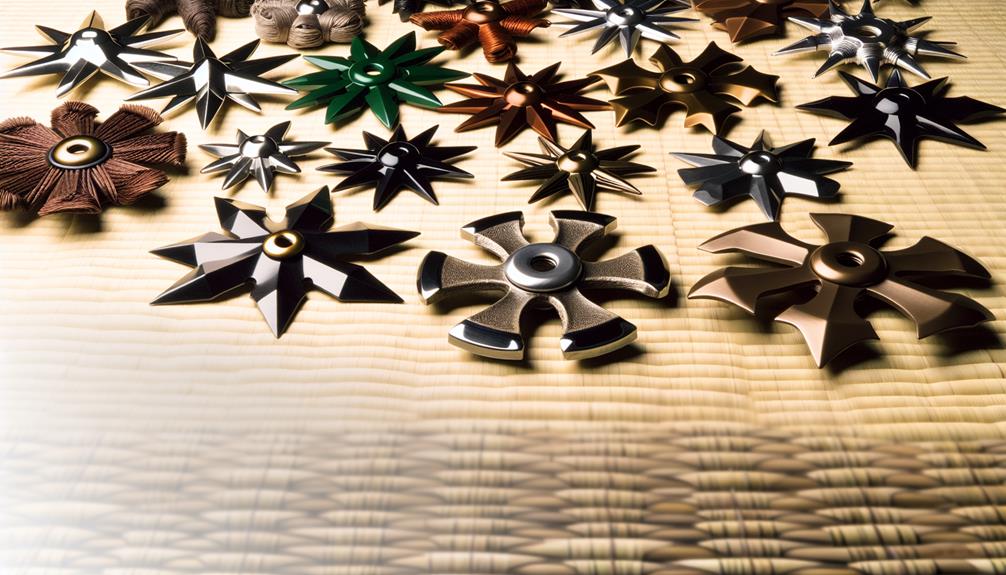
While throwing stars can be an intriguing option for self-defense, you might find other tools more practical and versatile. Exploring alternative weapons is essential in adapting to varied scenarios where personal safety is at risk.
You’ll discover that traditional martial arts often integrate weapons like the staff or nunchaku, which offer defensive strategies beyond the limited range of throwing stars. Moreover, modern techniques emphasize the use of tactical gear that aligns with current self-defense tools, enhancing your readiness and response capabilities.
Improvised devices also play a critical role in personal defense. Everyday items you carry—like pens, keys, or even a scarf—can be utilized effectively to protect yourself. This approach not only capitalizes on the practical applications of items at your disposal but also ensures you’re always prepared, regardless of the situation.
In terms of conflict resolution, it’s vital to understand that the best defensive strategy often involves de-escalation and avoiding confrontation altogether. Equip yourself with knowledge and skills in communication and negotiation as part of your comprehensive strategy for self-defense.
This balanced approach ensures you’re prepared for various circumstances, prioritizing your safety and well-being above all.
In self-defense scenarios, managing multiple attackers can be daunting.
You’d need reliable and effective methods to ensure your safety. While some tools might seem appealing, it’s crucial to consider practicality and ease of use under pressure.
Techniques that allow you to maintain distance and control the situation are typically more beneficial.
It’s essential to train in these methods to respond effectively when faced with such challenging situations.
Yes, throwing stars are typically detectable by metal detectors due to their metallic composition.
It’s crucial to consider the legality and history of throwing stars in your area, as they’re often classified as concealed weapons. Their historical use as tools for distraction rather than lethal force doesn’t change modern legal restrictions.
Yes, your throwing stars do require regular maintenance to ensure they remain effective and safe to use.
You’ll need to regularly clean and sharpen them, paying attention to the specific materials they’re made from as different metals might need different care.
Also, practicing your throwing star techniques is crucial; it ensures you’re not only maintaining the stars themselves but also your skill in handling them efficiently.
Don’t neglect either aspect for optimal performance.
Weather conditions significantly impact the performance of throwing stars.
If you’re using them, remember, moisture can rust metal, reducing durability and precision.
Extreme temperatures might warp or damage the material, lessening efficacy.
Always consider the material’s durability when dealing with varying environments.
Proper storage and occasional maintenance also help mitigate these effects, ensuring your throwing stars remain in top condition, ready for optimal performance regardless of the weather.
Absolutely, you can customize items to fit your specific needs.
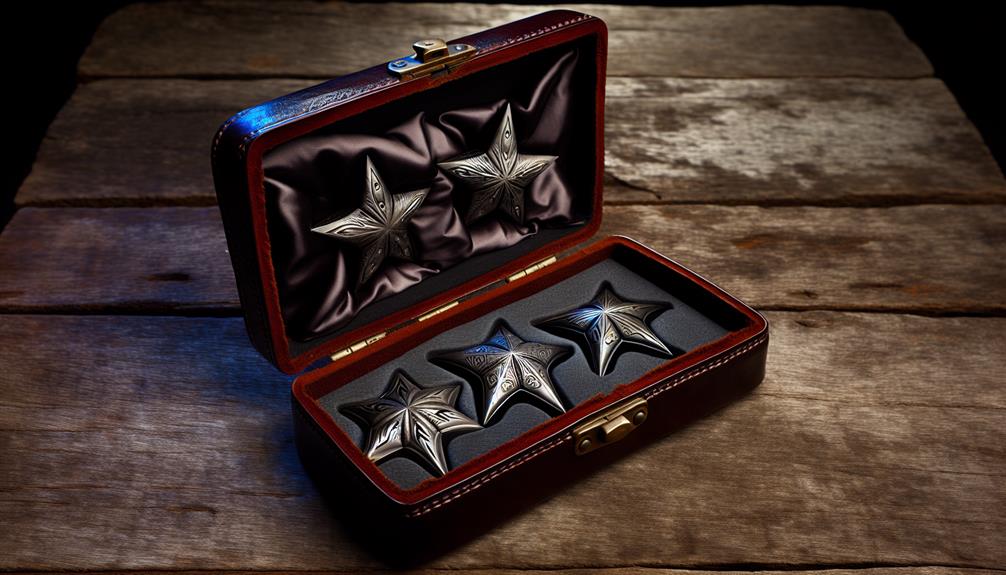
Whether it’s design preferences or material choices, tailoring them ensures they meet your unique requirements. Personalization allows you to select features that enhance usability and efficiency.
By choosing the right materials, you enhance durability and performance.
As you explore using throwing stars for self-defense, remember to check your local laws to ensure they’re legal. Choose the right shuriken and commit to proper training to master both basic and advanced techniques. Always prioritize safety and consider non-weapon alternatives for de-escalation. While throwing stars can be an effective tool, your safety strategy should focus on avoiding conflict first and foremost. Stay informed, prepared, and aware to best protect yourself.
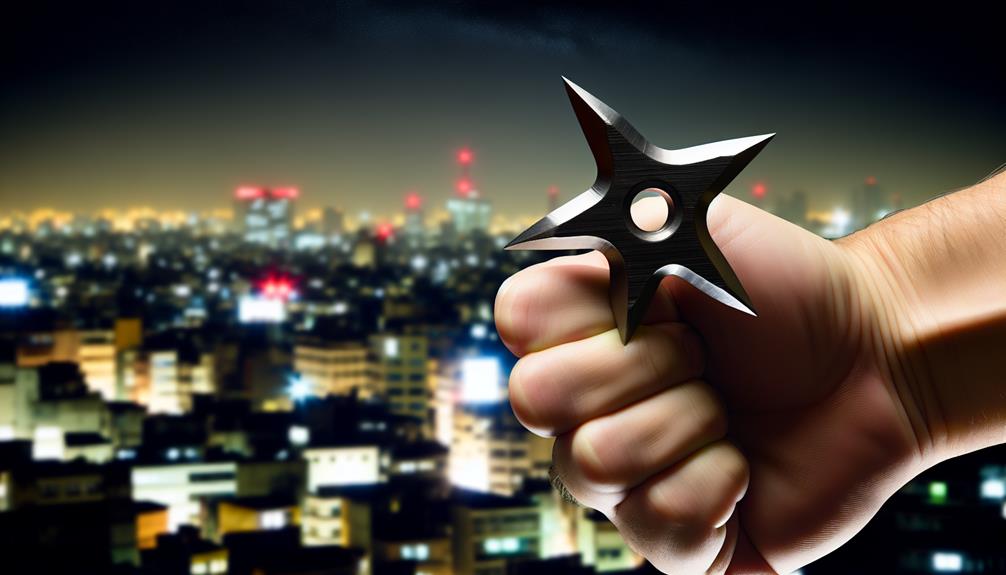
Brainstorm Security Shop
1867 Caravan Trail
Ste 105
Jacksonville, FL 32216
Call us toll free: (800) 859-5566